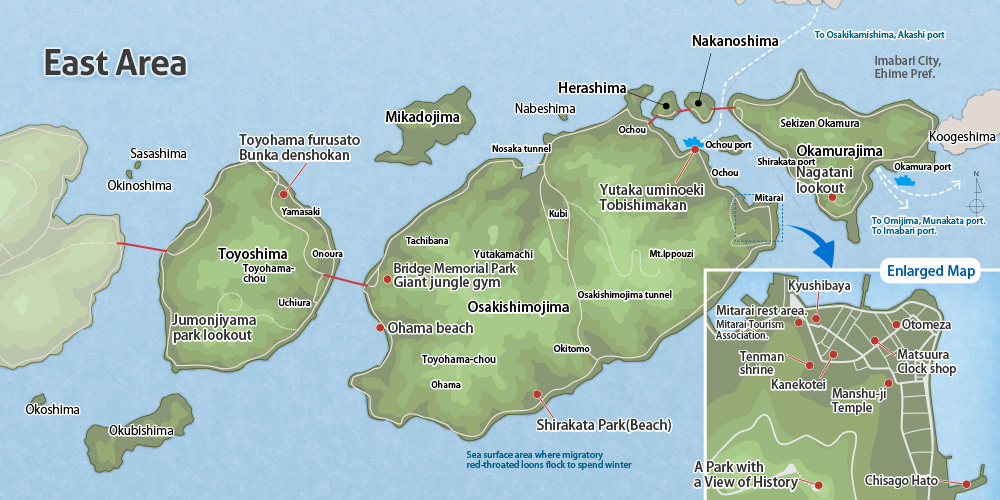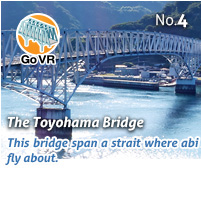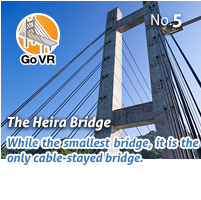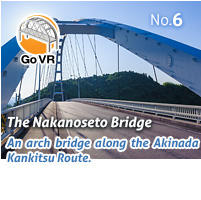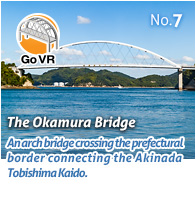The town of Toyoshima is spread along the Toyoshima Strait on the east side of the island. Its main industries are fishing and agriculture. As the area is blessed by the rich natural environment of the Seto Inland Sea so the island is packed with areas of untouched natural beauty. |
The west side of Osakishimojima Island is linked to Toyoshima Island by the Toyohama Bridge. The port town is located along the east side of the island and faces Ehime Prefecture. From higher ground, you can gaze out across the Seto Inland Sea, dotted with beautiful islands, all the way to the Kurushima Strait. |
Osakishimojima Island, Herashima Island, and Nakanoshima Island are part of Yutaka-machi in Kure city. They are linked by the Heira Bridge and the Nakanoseto Bridge. | Okamurajima Island is one of the Sekizen Islands of Imabari city in Ehime prefecture. It is linked to Hiroshima prefecture via the maritime agricultural bridge, the Okamura Bridge. There is also prefectural border marker that runs across the bridge. Okamura port is about a 10 minute drive from Osakishimojima Island and you can use the ferry to travel between Shikoku and Omishima Island from Okamura port. Okamura Island is also an important link between the Akinada Tobishima Kaido and the Setouchi Shimanami Kaido. Also part of the Seto Inland Sea National Park, one can see Osakishimojima town on the opposite shore, the coastline of Kannon-zaki Point and picturesque sea and islands stretching all the way to Shikoku. |
Toyoshima Island
The town of Toyoshima is spread along the Toyoshima Strait on the east side of the island. Its main industries are fishing and agriculture. As the area is blessed by the rich natural environment of the Seto Inland Sea so the island is packed with areas of untouched natural beauty.
In the stretch of ocean between Toyoshima Island and Itsukishima Island, fisherman work in harmony with Hiroshima’s prefectural bird, the red-throated loon to use an unusual, traditional technique called red-throated loon fishing.
Currently, the red-throated loon requires protection in this area.
Osakishimojima Island
The west side of Osakishimojima Island is linked to Toyoshima Island by the Toyohama Bridge. The port town is located along the east side of the island and faces Ehime Prefecture. From higher ground, you can gaze out across the Seto Inland Sea, dotted with beautiful islands, all the way to the Kurushima Strait.
The Island has a flourishing citrus cultivation industry centered in the Ocho district and is full of fields of tangerines.
The Mitarai district on the east side of the island developed long ago as a port town where sea farers would wait for favorable tides and favorable winds. Now, Mitarai has many culturally and historically significant buildings and coastal facilities. It has been designated an Important Preservation District for Groups of Traditional Buildings.
Herashima Island and Nakanoshima Island
Osakishimojima Island, Herashima Island, and Nakanoshima Island are part of Yutaka-machi in Kure city. They are linked by the Heira Bridge and the Nakanoseto Bridge.
Okamurajima Island
Okamurajima Island is one of the Sekizen Islands of Imabari city in Ehime prefecture. It is linked to Hiroshima prefecture via the maritime agricultural bridge, the Okamura Bridge. There is also prefectural border marker that runs across the bridge. Okamura port is about a 10 minute drive from Osakishimojima Island and you can use the ferry to travel between Shikoku and Omishima Island from Okamura port. Okamura Island is also an important link between the Akinada Tobishima Kaido and the Setouchi Shimanami Kaido. Also part of the Seto Inland Sea National Park, one can see Osakishimojima town on the opposite shore, the coastline of Kannon-zaki Point and picturesque sea and islands stretching all the way to Shikoku.
Tourist spots, VR Spots
Tourist spots, VR Spots

